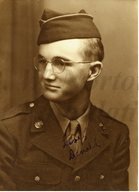
|

|
|
|
|
Donald was born in a shotgun house in a pipeline company camp in Burkburnett, Texas. He was the son of Daniel Clay and Ammah Thompson Carpenter. His father, who worked for Prairie Pipeline Company, soon moved the family to Oklahoma, where Donald grew up in a number of pipeline company camps in towns such as Maud, Sasakwa, and Pauls Valley. "We'd run around through the woods and on the river banks and play a little ball, ride my bicycle, sell magazines," is how he characterizes his boyhood. He says his family was fortunate in that his father "always had a good job and got pretty good pay and the housing was free." Donald graduated from high school in Pauls Valley in 1943. He enrolled at the University of Oklahoma at Norman, and worked for a mental hospital, taking patient identification photographs, a job that earned him room and board in a 40-hour week. Accepted into the Army Specialized Training Program, he began service on March 18, 1944. Before completing his basic training at Camp Carson in Colorado, he was placed in a field artillery pack unit, in which the weapons assemblies of 75-millimeter howitzers were packed on mules. "The mules were something not new to me," he says. "It wasn't so much of a shock to me as it was to some of the people." Donald became radio operator, often working with the artillery unit's forward observer. "That's where I learned more about mules," he says. "One thing about having the mules in the organization was that contrary to a lot of other outfits, a private was not the lowest rank member. We considered the mule a little less than human. However, some of the officers didn't think so." At Fort Riley, Kansas he was detailed to the cavalry school to teach pack animal training classes to new second lieutenants. From there he joined the 605th Field Artillery Battalion of the 10th Mountain Division, and was sent to Camp Swift near Bastrop, Texas. Later, after sailing to Italy, he was assigned as a lieutenant's jeep driver. "We very seldom used mules over there, except perhaps later on," he says of the pack artillery units. Instead trucks transported howitzers and other equipment. Donald participated in the breakout from the Apennine Mountains into the Po Valley, where U.S. forces "started moving helter-skelter, liberating one little town after another," he recalls. Often, he says grateful townspeople brought soldiers bread and wine. He recalls a sad incident in which 26 men in a DUKW (six-wheel amphibious truck) nearly drowned while crossing Lake Garda. Donald says he nearly drowned in another DUKW nearby. The next day was VE Day. He characterizes the end of the war in Europe as "more of a sense of relief than anything else," he says. "But the war was still on in Japan and that's what we were thinking about. We're heading to the Far East." Instead, he was stationed near the Yugoslav and Austrian borders before sailing home on a cargo vessel converted as a troop carrier. He was "halfway across the Atlantic" when he heard the news about the bombing of Hiroshima. After Donald's parents picked him up at the bus station in Oklahoma City, they began the drive home at 35 miles per hour, the wartime speed limit to save tires and gasoline. "About halfway home we heard the news that Japan had surrendered. My dad immediately increased the speed to fifty-five," he recalls. "I thought that was very unusual or unique or very appropriate that it was the same car I was sitting in when I heard the news of Pearl Harbor. And we heard the news that the Japanese surrendered in the same car as we rode the way home." Discharged in San Antonio on April 20, 1946, Donald re-enrolled at the University of Oklahoma where he earned a degree in mechanical engineering in 1950. He also entered the reserves, and joined ROTC on campus and earned a commission. He was sent on active duty to Fort Polk in Louisiana where he met Sue Edwards. They married on August 29, 1952. They would have three children, six grandchildren, and three great-grandchildren. At Fort Sill he completed Motor Officer Training and served as battery maintenance officer of headquarters battery. Meanwhile, he had applied for work at J.B. Beaird Company and was eventually hired. He worked 36 years with that company as an engineer before retiring in 1989. |


